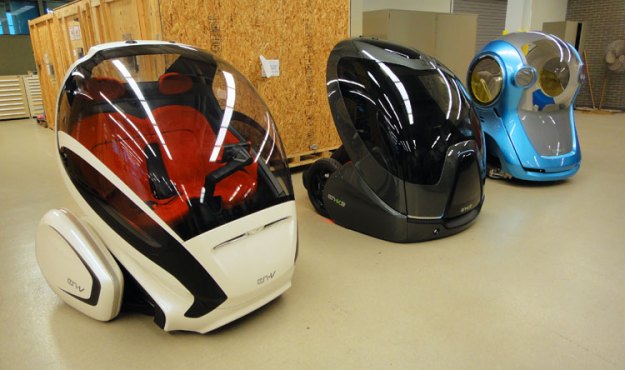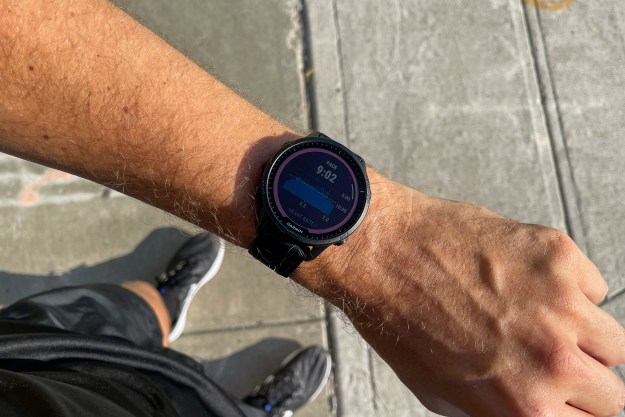
Lit with bright overheard fluorescents and littered with massive wooden crates the size of backyard sheds, GM’s R&D garage feels less like a hangout for grease monkeys and more like a Hollywood sound stage. The sleek, pod-shaped vehicles dotting the floor could be movie props. – or perhaps leftovers from Blade Runner or Total Recall, maybe. Until they sit up, almost silently, and begin moving. On two wheels no less.
The EN-V concept vehicle, which originally debuted in Shangai all the way back in 2010, represents GM’s vision of what the car may morph into by 2030. But don’t let the far-flung date fool you; all the technology exists to build the EN-V today, exactly as it looks. Quite unlike many other concepts that have done their time under the scorching lights at trade shows, the EN-V is far from dead or forgotten nearly two years later. It’s a vehicle waiting for its city.
Meet the all-knowing car
Though the EN-V’s balanced two-wheel operation no doubt draws crowds, it may be the least radical aspect of a design far deeper than its carbon fiber skin. The car, designer Chris Borroni-Bird is quick to point out, could just as well have three or four wheels. The magic lies in the parts you can’t see — it’s a computer on wheels.
EN-V stands for Electric Networked Vehicle. Rather than working toward a vehicle that could run longer, faster or be built cheaper, GM focused on making the EN-V smarter through connectivity, and the rest fell into place.

GM threw those conditions out for the EN-V, not because it will never see the light of real city streets, but because the streets it will someday roam will be crash free. In theory, at least.
Through a sophisticated array of sensors and car-to-car communication, the EN-V should essentially be uncrashable. Besides always knowing where it is in a city, the car should more importantly know where every other nearby car is, with backup sensors for other obstructions — like pedestrians and bicyclists. Using short-range radios that can communicate with vehicles blocks away, the EN-V can keep tabs on all the networked cars around it, braking before a T-bone at the next light, speeding up to avoid a rear-end collision, or changing lanes to make room for another car entering the flow of traffic.
Stop worrying about accidents, and suddenly you can stop building a car around the worst-case scenario. And if you stop building a car around the worst case scenario, it gets smaller and lighter. Make a car smaller and lighter, and the batteries will carry it further. The benefits of a networked vehicle in a networked city trickle down into every aspect of its design.
Why not public transportation?
While many futurists envision future metropolises full of maglev trains, subways and other public transportation, GM (perhaps not surprisingly) still sees a place for cars in future cities. After all, despite the overwhelming cost and hassle of keeping one in urban areas, city dwellers still go out of their ways to keep four wheels around.
“You have to ask the question: Why does everyone want to be in a car when everyone is complaining about parking and congestion, gridlock and so forth?” Borroni-Bird points out. “What does the car provide that alternatives like the bus or the train or walking or cycling don’t provide?”
GM’s answer: The freedom to choose where you go, when you go, with who you go. The ability to carry stuff. To feel protected from the weather. To feel safe and secure. “Those are attributes of a car that we wanted to preserve,” Borroni-Bird says. “But we wanted to reduce some of the side effects of the car in an urban environment.”

Besides the obvious safety benefits of car-to-car communication, a truly networked car has other perks as well. Using GPS to navigate streets and the sensor network to avoid accidents on them, the EN-V could drive autonomously without thousands of dollars in sensors, like other prototype autonomous cars. The LIDAR equipment on DARPA’s Urban Challenge competitors, for instance, is both enormous and expensive. Scaling it back to deal with either of those problems reduces accuracy — not something you want to skimp on when you’re relying on it to safely pilot a ton of rolling steel. By contrast, the EN-V uses just an acoustic distance sensor and an inexpensive 2D camera, with car-to-car data and GPS to fill in the gaps. Just hop in, tell it where you want to go, and you’re rolling.
Small size has its own perks. With the space saved by eliminating crash zones, you can park three of EN-Vs in the same spot it would take to fit one full-size car, and the two-wheeled design allows it to spin 360 degrees in place to navigate into minuscule spaces even a Mini driver would roll right by. Not that you would need to look for parking: A smart city would include parking space sensors similar to the ones used in modern parking garages to measure capacity, then point the EN-V directly to an open spot near your destination. In densely populated urban areas, GM researchers found that roughly a third of drivers on the roads were simply looking for parking. Cut that out, and congestion dissipates without barring anyone from the streets.
Ride-Along
So in theory, it’s the perfect urban vehicle. But what’s it like to ride in?
Getting settled into GM’s robotic ride for the first time can be an intimidating prospect. The tall, narrow pod seems ready to topple as soon as you hop in, but in its parked state, the EN-V feels rock solid, resting forward on unseen supports. Take a seat in the futuristic red velour seats, buckle in with a lap belt clearly pulled from the GM parts bin, and you’re ready to go.
The two-wheeled design was actually developed as a joint project between GM and Segway, initially unveiled as the PUMA platform back in 2009. Like a traditional Segway, it uses gyros and subtle torque to the wheels to keep upright, but also has a sliding carriage portion that moves back and forth to center the car’s weight over the wheels. After taking a seat, it almost imperceptibly shimmies back from a parked forward-leaning stance to stand fully upright on two wheels — no training wheels required.

The controls for the EN-V actually rest between driver and passenger in a center console, where they perch on a folding arm that wouldn’t look out of place in the Millennium Falcon. No pedals here; just a touchscreen with two red arms on either side that act like a game controller (that’s no coincidence, GM got the idea from a Logitech gaming peripheral). Push them both forward and you go straight, push one side a little harder than the other and you can steer. Yank back to brake. It’s like a zero-turning radio lawn mower, minus the mulching.
The ride, surprisingly enough, is smooth and almost totally silent, save for the quiet hum of the electric motors. Even as they make tiny adjustments to keep the EN-V upright and steady, the pod feels solid and surefooted.
The benefits of a two-wheeled design are immediately obvious: After zipping around the garage down a narrow gap between crates barely wide enough for the EN-V, it comes to a brick wall. No worries. It rolls to a stop and turns around as if on a turntable, then motors out the way it came. With a giant acrylic dome for a windshield, there isn’t much you can’t see.
The car of the future feels surprisingly like sitting behind the screen of a first-person shooter – fluid, effortless and agile.
The long road to uncongested roads
While GM’s vision of an autonomous, uncrashable, pollution-free and intelligent vehicle is an encouraging thought for city dwellers fed up with gridlock, smog and the frustration of circling for parking, there remain major barriers to ever seeing one on the street.
For one thing, without meeting the same safety standards, it could never share the roads with the likes of a Suburban in the U.S. For car-to-car communication to work its crash-erasing magic, every car on the road would need to have it, which could be decades off. While smartphones could potentially help fill the gap by putting older cars and pedestrians “on the grid,” ultimately, a lot infrastructure — like traffic lights and parking spaces — would have to be equipped as well. That’s simply not going to happen overnight.
If anything, GM says, we might see EN-V vehicles popping up in more isolated locales first, like golf courses or military bases. A fleet operating there could be safely sequestered from vehicles that can’t “talk,” giving GM a real-life look at how a colony of smart vehicles might operate.

Eventually, the EN-V should also find its way to Tianjin’s Eco City, a joint project between the governments of China and Singapore. The project will literally be a city that sprouts up out of nowhere on the outskirts of Tianjin, emphasizing new technologies for greener living — like the EN-V. In late 2011, GM signed a memorandum of understanding with the developers to integrate the EN-V into the futuristic city’s infrastructure. Again, its isolation from traditional forms of transportation could make it an ideal test bed for the EN-V, though development won’t take place until the early-to-mid 2020s.
Having already won the battle to make it from the drawing board to functional prototype, an even more advanced EN-V model is on the way. The next-gen prototype will wear Chevy branding and address livability issues that didn’t need to exist in the first-gen proof-of-concept, like climate control, personal storage space and all-weather and road condition operation.
Ultimately, even if the EN-V never makes the transition to crowded city streets, GM has made its point clear: Newer cars won’t just have to go faster, further, or use less fuel. To make increasingly crowded cities work in a world that now bustles with the activity of 7 billion people, they’re going to need to get a lot smarter.
Also check out our photo gallery for official pictures of the EN-V concepts.


